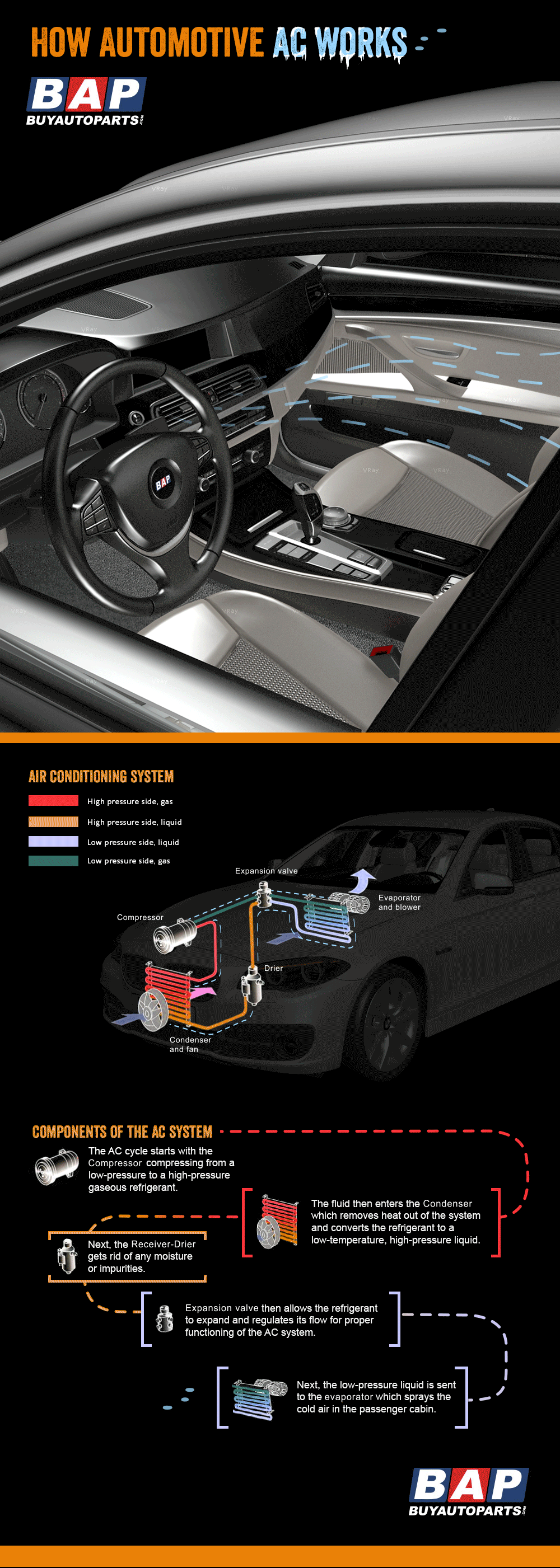We created the infographic above to help those of you who were curious to understand how the automotive AC system works. Understanding the AC system might be the least of your worries when all is well and the air is blowing nice and cold, but once something goes wrong we all wish we knew how to troubleshoot. Knowing how each of these components works is the first step doing this.
AC Compressor
The central and most important component of the AC system is the air conditioning compressor (AKA the AC compressor). This is also where the AC cycle starts, therefore in the graphic above you will see the compressor light up first to help show you the flow of the system. The function of the AC compressor as its name implies; is to COMPRESS refrigerant from a low-pressure gaseous refrigerant to a high-pressure gaseous refrigerant.
AC Condenser
The primary responsibility of the condenser is to remove heat out of the system and convert the refrigerant into a low-temperature, high-pressure liquid. In many ways, the condenser is the radiator of the AC system. This is the second component shown in the graphic’s AC flow above.
Receiver-drier
Call it small, but don’t call it insignificant. The next step in the AC flow is incredibly important to a well-functioning system. The receiver (or drier, depending on the vehicle) gets rid of any moisture or impurities in the refrigerant flowing through the system. Without a properly working receiver your system would get clogged up real fast and everything would just stop working. That’s no fun, so thank the little receiver for doing its job so well!
Expansion valve
In this step of the AC flow a device called the expansion valve (sometimes referred to as an expansion device) allows the refrigerant to expand while also regulating the flow of refrigerant to allow the AC system to function properly. Another important function of the expansion valve is it reduces refrigerant pressure converting it into a low-pressure liquid.
Evaporator
The evaporator is the final major component of the AC system, and it serves the purpose of spraying cold air into the passenger cabin and thus taking away the heat from the passenger cabin.
The passenger cabin’s temperature then turns the low-pressure liquid refrigerant into a low-pressure gaseous refrigerant, which thus enters the AC compressor and re-starts the next AC cycle.
You must be thinking: “Well that was simple!” Or maybe not, but most certainly be on the lookout for our next infographic about how to keep your AC cold. We know that understanding the way something works is only half the battle to actually fixing the unfortunate problem of not having an AC system that blows nice cool air into your passenger cabin.
For those of you looking to just complete the repair ASAP head to our AC Compressor page to get started. You can start the process here or simply select your year, make and model with the vehicle selectors in the navigation bar above. If you need any further assistance, hit us up. We have a full team of automotive air conditioning professionals ready to help you out.
If you would like to embed or share this infographic on your website or blog, please use the embed code below!


